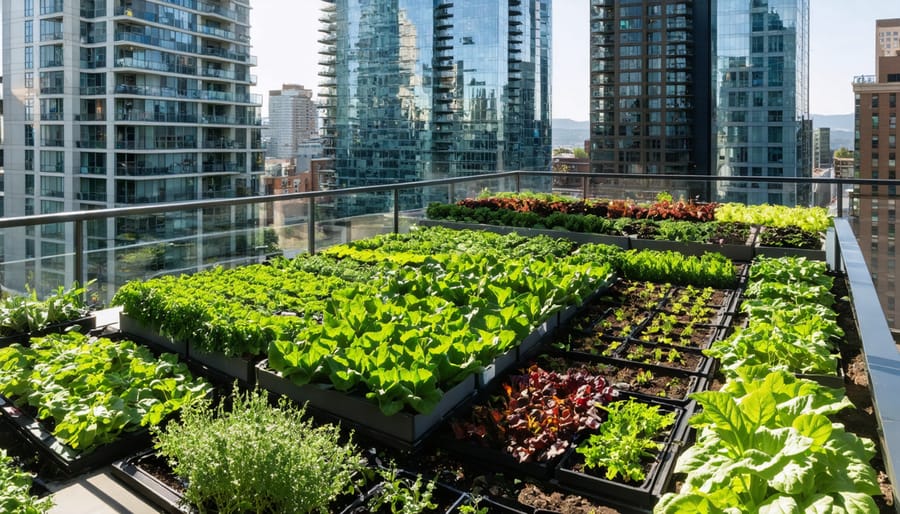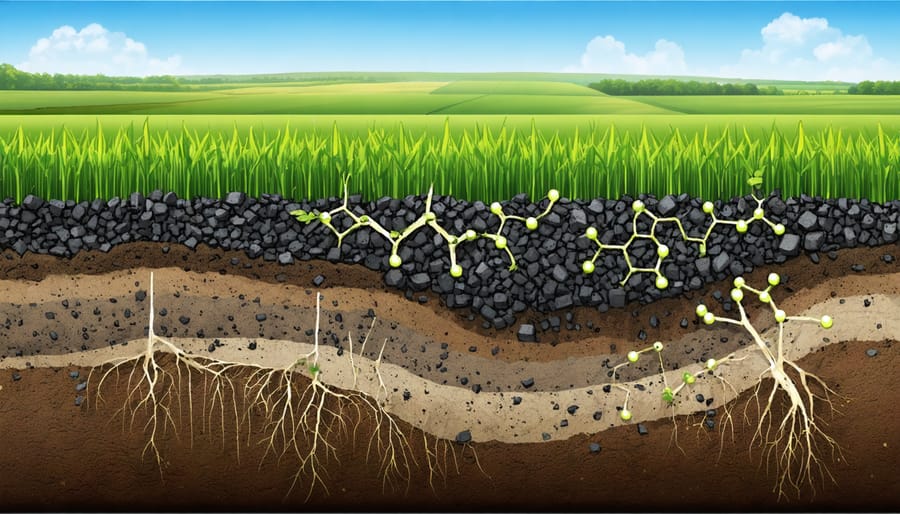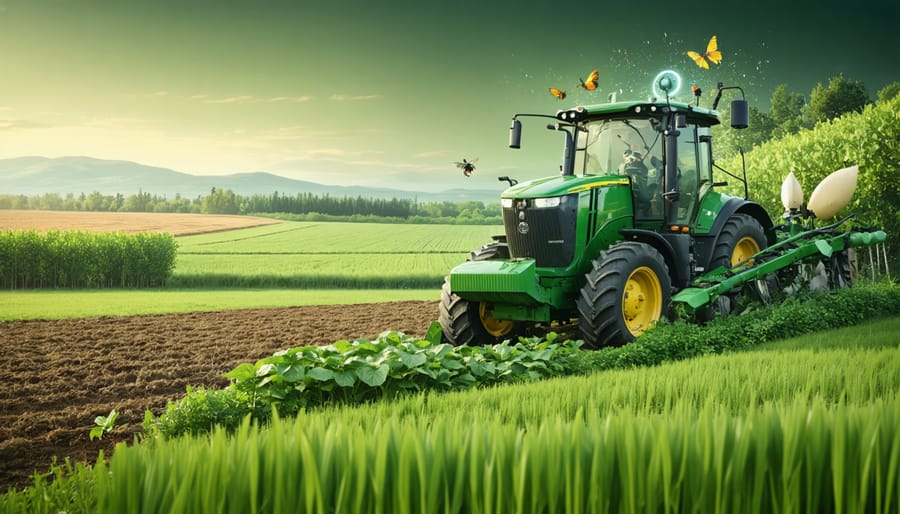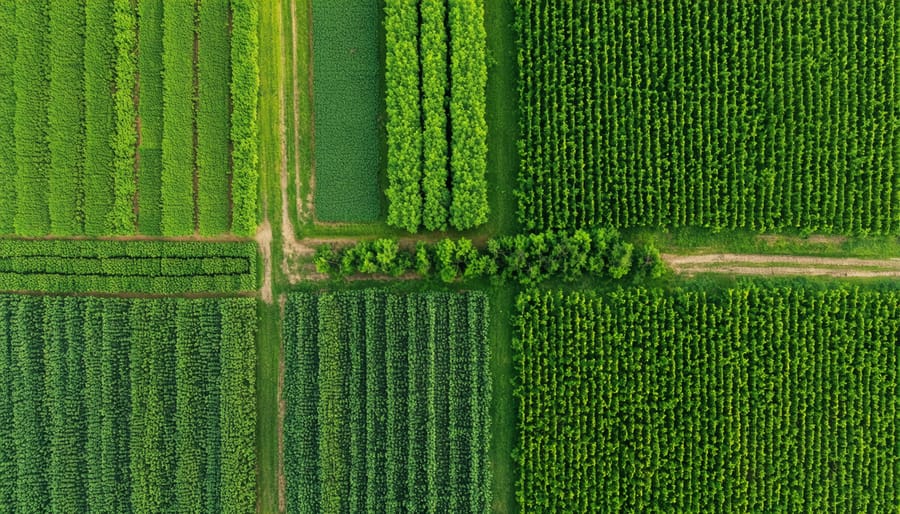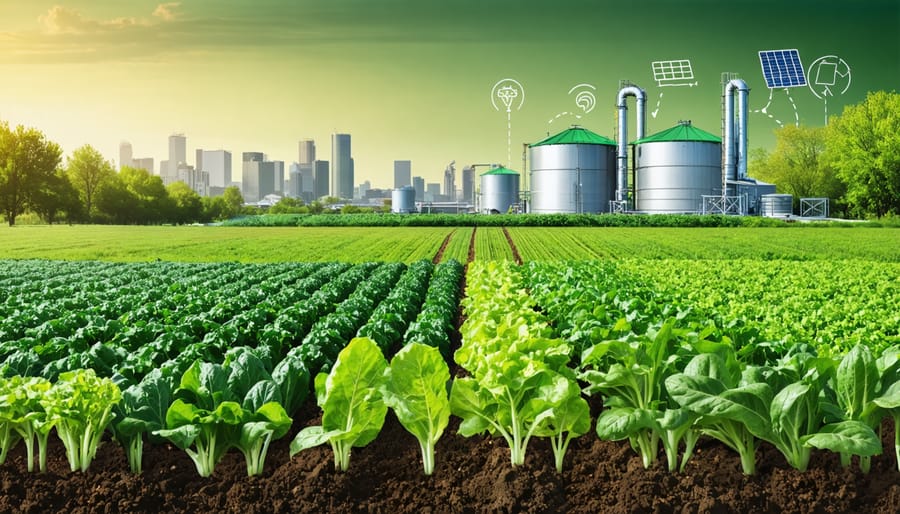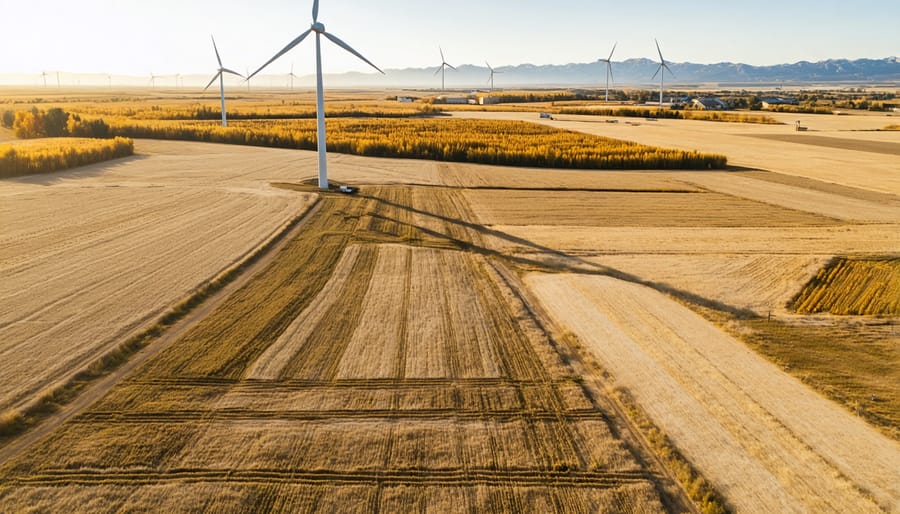Transform unused rooftop spaces into thriving vegetable gardens, following successful models like Calgary’s Grow Calgary initiative, which produces over 2,000 kg of fresh produce annually on a single acre. Scale vertical farming operations in repurposed warehouses using hydroponic systems, demonstrated by Edmonton’s Urban Ag Tech, achieving 15-20% higher yields than traditional farming methods while using 90% less water. Implement sustainable urban agriculture practices through community-based aquaponic systems, exemplified by Lethbridge’s FoodShare program serving 500+ families monthly. Convert vacant lots into productive micro-farms using intensive growing methods, proven successful by Red Deer’s Urban Roots collective, which transformed 12 city lots into productive growing spaces yielding 4,500 kg of vegetables in their first season. These innovative approaches showcase how Canadian cities leverage existing infrastructure to create viable, community-supporting food systems while maximizing limited urban space.
Rooftop Gardens That Feed Communities
The Calgary Tower Garden Project
Located in the heart of downtown Calgary, the Calgary Tower Garden Project has transformed 750 square metres of previously unused rooftop space into a thriving urban farm. Launched in 2019, this innovative initiative now supplies fresh produce to five restaurants within the tower complex and surrounding downtown establishments.
The garden utilizes a combination of hydroponic systems and traditional soil-based growing methods, carefully selected to withstand Calgary’s unique climate challenges. During the growing season (May to September), the garden produces approximately 2,300 kilograms of vegetables, herbs, and edible flowers annually, significantly reducing the participating restaurants’ reliance on imported produce.
Project coordinator Sarah McKenzie explains, “We’ve designed our growing system to maximize productivity in our short growing season. Our greenhouse extension allows us to start seedlings earlier and extend harvest into late October, while our vertical growing systems help us make the most of limited space.”
The garden employs three full-time urban farmers who manage crop rotation, maintenance, and daily harvesting. Local culinary students also participate in a hands-on internship program, learning about urban agriculture while helping with garden operations.
The project’s success has inspired similar initiatives across Alberta, demonstrating how commercial buildings can contribute to local food security while creating valuable educational opportunities and strengthening connections between urban farmers and local restaurants.
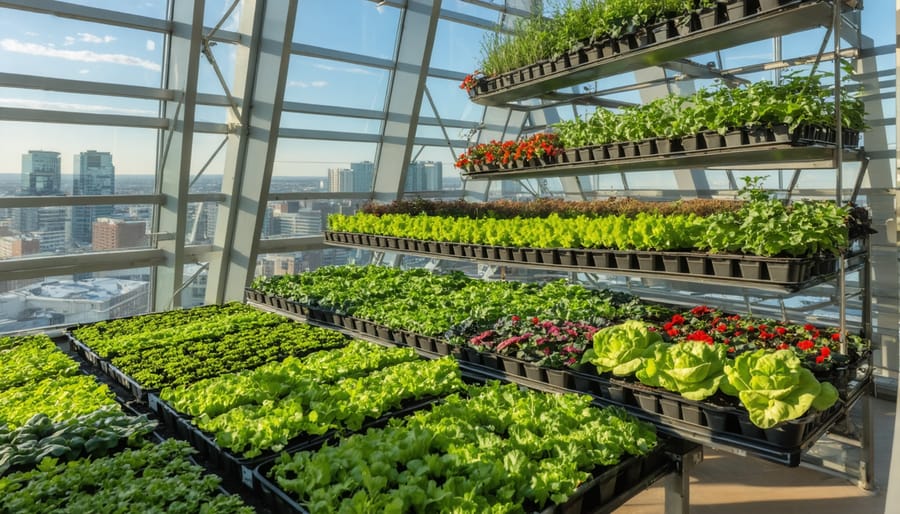
Edmonton’s High-Rise Harvest
In the heart of downtown Edmonton, the Jasper Avenue Apartments transformed their rooftop and balcony spaces into a thriving vertical garden community in 2019. This 15-story residential building now produces over 2,000 kg of fresh produce annually, proving that height is no barrier to urban agriculture.
The project, spearheaded by resident coordinator Sarah McKinnon, utilizes a combination of container gardens, vertical growing systems, and hydroponic towers. Each floor maintains dedicated growing spaces, with residents collaborating to tend vegetables, herbs, and edible flowers suited to Edmonton’s climate.
“We started with just a few tomato plants on the roof,” explains McKinnon. “Now we have over 40 families actively participating, growing everything from kale and peppers to indigenous medicinal plants.” The building’s success lies in its innovative use of micro-climates created by its architectural features, protecting plants from strong winds while maximizing sun exposure.
The community has implemented a sophisticated composting system and rainwater collection network, reducing waste and water consumption. Regular workshops help new residents learn growing techniques, while a produce-sharing program ensures harvests benefit all building occupants.
Most impressively, the initiative has reduced grocery bills for participating families by an average of $800 annually while strengthening community bonds. The project now serves as a model for other high-rise developments across Alberta, demonstrating how vertical spaces can contribute to urban food security.
Vertical Farming Solutions
The Lethbridge Vertical Farm Initiative
Located in a former electronics warehouse on the outskirts of Lethbridge, the Vertical Farm Initiative has transformed 2,800 square metres of industrial space into a thriving hydroponic growing facility. Since its launch in 2019, this innovative project has demonstrated how urban spaces can be repurposed to create efficient food production systems that complement traditional farming methods.
The facility utilizes a state-of-the-art vertical hydroponic system, with plants arranged in stacked layers that maximize growing space. LED lighting systems, calibrated to specific crop needs, provide optimal growing conditions year-round, while automated nutrient delivery systems ensure precise feeding schedules. This setup allows the facility to produce approximately 450,000 kilograms of leafy greens and herbs annually, using 90% less water than conventional farming methods.
What sets this initiative apart is its community integration approach. The facility partners with local restaurants and grocers, ensuring produce reaches consumers within hours of harvest. They’ve also established an educational program that welcomes school groups and aspiring urban farmers, sharing knowledge about hydroponic growing techniques and how to develop a self-sustaining food forest.
The project employs 15 local residents and has become a model for similar initiatives across Alberta. Their success has prompted the development of a mentorship program, where experienced staff guide other communities in establishing their own vertical farming operations, fostering a collaborative approach to urban agriculture development in the region.
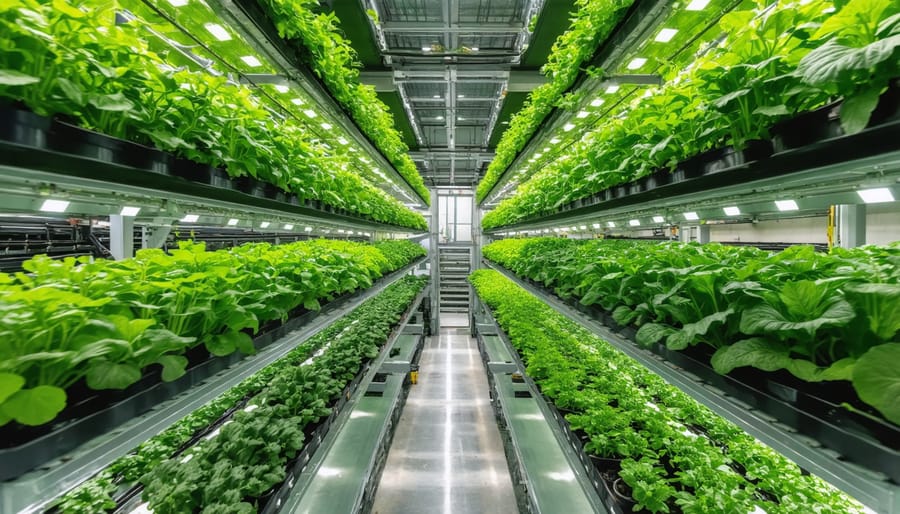
Red Deer’s Container Farm Network
Red Deer’s innovative approach to year-round urban farming has revolutionized local food production through its network of shipping container farms. These climate-controlled units, each measuring approximately 40 square metres, operate throughout Alberta’s harsh winters, producing fresh vegetables and herbs regardless of external conditions.
The initiative, launched in 2019, combines advanced hydroponics with organic growing practices to yield impressive results. Each container can produce up to 500 heads of lettuce weekly, equivalent to what traditional farming methods would require on 0.4 hectares of land.
Local farmer Sarah McKenzie, who manages two container units, shares, “We’re achieving consistent harvests every week, using 95% less water than conventional farming. The controlled environment means we can maintain optimal growing conditions year-round, something that’s particularly valuable during our Alberta winters.”
The network currently comprises eight container farms, strategically placed throughout Red Deer, supplying fresh produce to local restaurants, markets, and community food programs. The success has inspired neighboring communities, with similar projects now emerging in Sylvan Lake and Lacombe.
The container farm network also serves as an educational hub, offering workshops on hydroponic farming and sustainable agriculture. Local schools regularly visit these facilities, giving students hands-on experience with modern farming techniques while learning about food security and sustainable production methods.
Community Garden Transformations
The Medicine Hat Food Forest
Nestled in the heart of Medicine Hat, Alberta, the Medicine Hat Food Forest stands as a testament to community-driven urban agriculture. Established in 2015 through a collaborative effort between local permaculture enthusiasts and the City of Medicine Hat, this 0.4-hectare site has transformed from vacant land into a thriving ecosystem of edible plants.
The food forest implements a seven-layer permaculture design, incorporating tall nut trees, fruit trees, berry bushes, herbs, vegetables, ground cover plants, and root crops. This design maximizes vertical space while creating a self-sustaining system that requires minimal maintenance. Native species like Saskatoon berries and chokecherries grow alongside adapted fruit trees such as Evans cherries and hardy apple varieties.
What makes this project particularly successful is its community engagement model. Local volunteers, known as “Forest Guardians,” maintain the space through regular work bees and educational workshops. The harvest is shared among volunteers, with excess produce donated to local food banks and community kitchens.
The site also serves as an outdoor classroom, where schools and community groups learn about sustainable food production, biodiversity, and ecosystem services. Annual events like the Harvest Festival bring together hundreds of residents, fostering community connections while celebrating local food production.
The Medicine Hat Food Forest demonstrates how urban spaces can be transformed into productive landscapes that benefit both the environment and the community.
Grande Prairie’s Neighbourhood Farm
In the heart of Grande Prairie’s residential area, a remarkable transformation has taken place as local residents have converted their traditional lawns into productive growing spaces. Led by community organizer Sarah Thompson, this initiative began in 2019 when five neighbouring households decided to maximize their yard space for food production.
The project now spans 15 connected properties, creating a seamless network of garden plots that produce over 2,500 kilograms of vegetables annually. Residents have implemented innovative space-saving techniques, including vertical growing systems and succession planting, allowing for maximum yield in limited space.
What makes this project particularly notable is its cooperative approach. Participating households share resources, tools, and knowledge, while operating under a unified growing plan. The neighbours have established a shared greenhouse for starting seedlings and extending the growing season, crucial for Alberta’s shorter growing period.
The initiative has caught the attention of municipal planners, who are now studying its potential as a model for other residential areas. Beyond food production, the project has strengthened community bonds and reduced grocery bills for participating families by an average of 30% during the growing season.
The success has inspired similar projects across Alberta, with the Grande Prairie team offering monthly workshops to help other communities start their own neighbourhood farming initiatives. Their comprehensive guide to residential food production has become a valuable resource for urban farmers throughout the province.
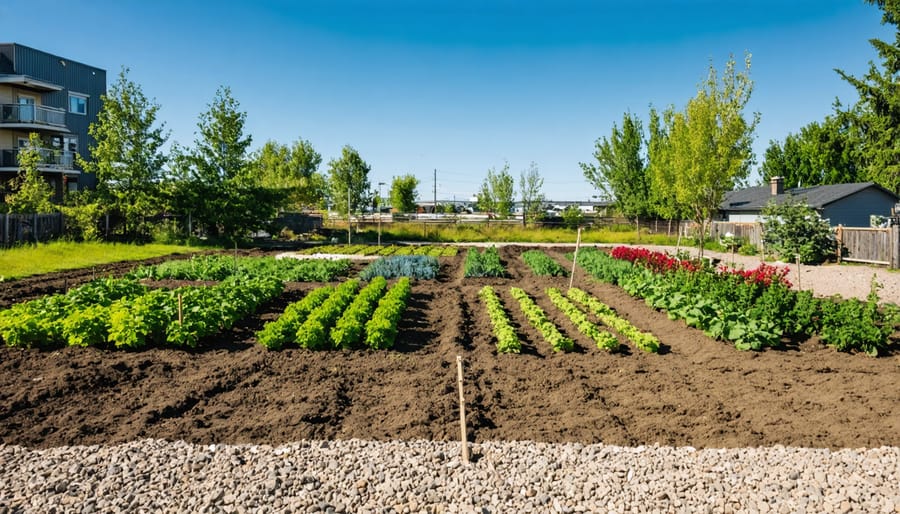
Urban Farming Technology Integration
Smart Irrigation Systems
Modern urban farms in Alberta are increasingly adopting smart irrigation systems to maximize water efficiency while maintaining optimal crop yields. These innovative systems combine sensors, automation, and data analytics to deliver precise amounts of water exactly when and where plants need it. At the Grow Calgary community farm, implementing smart drip irrigation has reduced water consumption by 40% compared to traditional sprinkler systems.
These intelligent systems typically include soil moisture sensors, weather monitoring stations, and automated controls that adjust watering schedules based on real-time conditions. For example, the rooftop garden at Edmonton’s MacEwan University uses a sensor-driven irrigation system that automatically adjusts water flow based on soil moisture levels and weather forecasts, demonstrating effective water conservation methods in action.
Many urban farmers in Calgary and Edmonton are now using smartphone apps to monitor and control their irrigation systems remotely. These apps provide detailed analytics on water usage patterns and plant health metrics, allowing farmers to make data-driven decisions about their watering schedules.
The initial investment in smart irrigation technology typically pays for itself within two growing seasons through reduced water bills and improved crop yields. The Bridgeland Community Garden in Calgary reported a 30% reduction in water costs after installing a smart irrigation system, while maintaining healthy crop production throughout the growing season.
Climate-Controlled Growing Spaces
In Alberta’s challenging climate, innovative climate-controlled growing spaces are revolutionizing urban farming. The Edmonton Urban Farm’s 900-square-metre greenhouse facility demonstrates how year-round production is possible even when temperatures drop below -30°C. Using LED grow lights and hydroponics systems, they maintain optimal growing conditions for leafy greens and herbs throughout winter.
Calgary’s Highfield Regenerative Farm showcases another successful approach with their container farming units. These repurposed shipping containers, equipped with vertical growing systems and automated climate control, each produce up to 500 heads of lettuce weekly regardless of external weather conditions.
Red Deer’s Community Growing Hub utilizes passive solar greenhouse design combined with ground-source heat pumps, reducing energy costs while maintaining consistent growing temperatures. Their double-wall polycarbonate construction and thermal mass water barrels help regulate temperature swings between day and night.
Local success story Fresh Cup Farms in Lethbridge demonstrates the viability of commercial-scale indoor farming. Their 2,000-square-metre facility uses advanced environmental controls and vertical farming techniques to grow microgreens and specialty crops year-round, supplying local restaurants and markets even during the harshest winter months.
These climate-controlled spaces typically maintain temperatures between 18-24°C and relative humidity levels of 50-70%, creating ideal growing conditions for a variety of crops. Many facilities incorporate water recycling systems and energy-efficient technologies to keep operating costs manageable while maximizing production.
Urban farming in Alberta has demonstrated remarkable potential for transforming our cities into more sustainable, food-secure communities. From rooftop gardens in downtown Calgary to community greenhouses in Edmonton, these initiatives have shown that agriculture can thrive in urban settings while bringing numerous benefits to local residents.
The impact of urban farming extends far beyond food production. These projects have created valuable educational opportunities, strengthened community bonds, and contributed to environmental sustainability. In Edmonton alone, urban farming initiatives have helped reduce food transportation emissions while providing fresh, locally-grown produce to thousands of residents.
Looking ahead, the future of urban farming in Alberta appears promising. With advancing technologies and growing public interest, we’re seeing increased support from municipal governments and private sectors. Innovation hubs are developing new solutions for year-round growing, while educational institutions are incorporating urban agriculture into their curricula.
The potential for expansion is significant. Unused spaces like vacant lots and building rooftops present opportunities for new farming projects. The integration of smart technologies and automated systems could further enhance productivity and efficiency, making urban farming more accessible to a broader range of participants.
As climate change continues to impact traditional farming methods, urban agriculture offers a resilient alternative that complements existing food systems. By combining traditional agricultural knowledge with modern innovation, Alberta’s urban farming movement is well-positioned to play a crucial role in our province’s food security strategy.
The success stories we’ve seen across Alberta demonstrate that urban farming is not just a trend but a viable solution for sustainable food production. As we move forward, continued collaboration between communities, government bodies, and agricultural experts will be essential in realizing the full potential of urban farming in our province.

